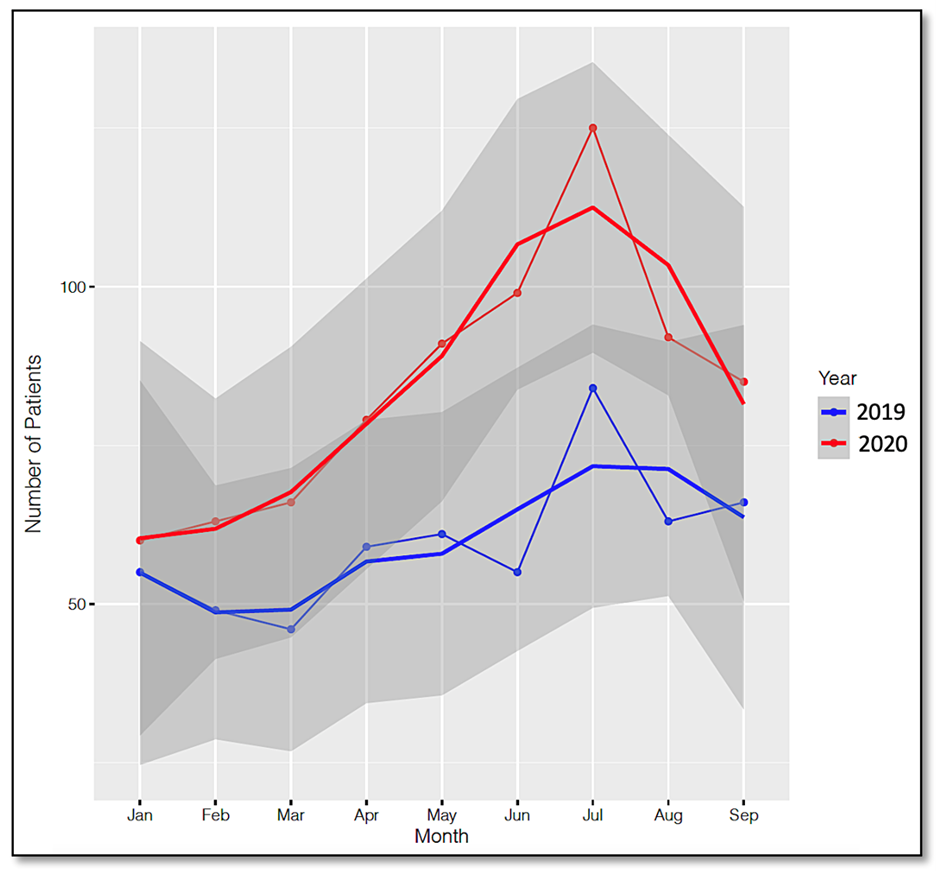Research to be presented at the 2021 American Academy of Pediatrics National Conference & Exhibition finds that the COVID-19 pandemic and stay-at-home orders led to a marked increase in accidental burns among children, spiking in July 2020
ITASCA, IL – During the 2020 COVID-19 pandemic, when many children were staying at home for school and were potentially unsupervised, kids experienced greater risk of accidental injuries, including burns.
The study abstract, “A Multi-Institutional Study Evaluating Pediatric Burn Injuries During the COVID-19 Pandemic,” to be presented at the virtual American Academy of Pediatrics National Conference & Exhibition, collected data about burn injuries from nine trauma centers and found that burn injuries for children grew significantly in 2020, when most children were schooling from home, compared to the same period in 2019.
“COVID-19 and stay-at-home orders inevitably created a new dynamic between children and their social environment. One result was the increased risk of burns those children experienced,” said Christina Georgeades, MD, an abstract author and a Pediatric Surgery Research Fellow at Children’s Wisconsin. “Understanding specific factors that contributed will be key in minimizing the risk of future burn injuries as we continue to navigate the pandemic environment.”
The total number of children with burn injuries increased by 32.5%, up to a total of 522 patients at the nine trauma centers in 2020, compared to 394 patients at the same centers in 2019. This may have been due to school closures that caused children to spend more time in their homes, which is where most burns occur.
Researchers believe that fireworks could have potentially played a part in the increase in burn injuries. Though all types of burns increased, the biggest increase between 2019 and 2020 were burns from exposure to open fire which would include firework-related injuries. Also, burn injuries spiked in July, which is a month when firework injuries are very common due to the Independence Day holiday. Finally, professional firework shows were canceled across the country in 2020, which may have driven an increased interest in amateur fireworks with a consequent increase in the risk of associated burn injuries.
Dr. Georgeades will present the study abstract at 10:24 a.m. CT on Sunday, October 10, 2021.
To request an interview, journalists may contact the senior author, Dr. Katherine Flynn-O’Brien.
This study was supported and conducted through the Midwest Pediatric Surgery Consortium, a collaborative of surgeon investigators from 11 children’s hospitals dedicated to advancing the care of pediatric patients.
Please note: only the abstract is being presented at the meeting. In some cases, the researcher may have more data available to share with media or may be preparing a longer article for submission to a journal.
# # #
The American Academy of Pediatrics is an organization of 67,000 primary care pediatricians, pediatric medical subspecialists and pediatric surgical specialists dedicated to the health, safety and well-being of infants, children, adolescents and young adults. For more information, visit www.aap.org.
Program Name:
Abstract Title: A Multi-Institutional Study Evaluating Pediatric Burn Injuries During the COVID-19 Pandemic
Amelia Collings
Louisville, KY, United States
Sunday, October 10, 2021: 10:24 AM –
During the COVID-19 pandemic, children were out of school due to Stay-at-Home orders, and were potentially unsupervised, increasing their risk for unintentional injury. The objective of this study was to investigate how these events impacted the incidence of burn injuries in children.
A total of 9 Level I pediatric trauma centers participated in a retrospective study evaluating children <18 years of age with traumatic injuries as defined by the National Trauma Data Bank were included. Patients with burn injuries were defined by ICD-10 Diagnosis and/or External Cause of Injury Codes. Historical controls from March-September 2019 (“Control” cohort) were compared to patients injured after the implementation of the Stay-at-Home Orders from March through September 2020 (“COVID” cohort).
A total of 13,177 pediatric trauma patients were included, of which 987 patients had burn injuries. The total number of children with burn injury increased by 48.6% in 2020, compared to 2019 (COVID cohort 590 patients vs. Control cohort 397 patients; p-value < 0.001), of which 94% was explained by unintentional injury. School aged children accounted for the largest difference in burn injuries between the two cohorts [Table 1]. The average number of burn-injured patients admitted per month increased over time and the difference between 2019 and 2020 peaked in July [Figure 1]. Compared to 2019, the proportion of children sustaining flame burns increased significantly in 2020 (Control 19.1% vs. COVID 26.1%, p=0.0014).
During the COVID-19 pandemic, families experienced unprecedented increased social and financial pressure, and children were out of school for extended periods of time. This time period coincided with a considerable increase in burn injuries. The disproportionate increase in burn injuries in July may reflect the cancellation of professional firework shows across the nation and an increase in amateur pyrotechnicians experimenting with their own fireworks. The onset of the COVID pandemic introduced an extraordinary set of events with unclear consequences.
Table 1: Distribution of age in pediatric burn patients

Figure 1: Comparison of pediatric burn injuries over time with both exact values (notched line) and LOESS smoothing (bold line)
